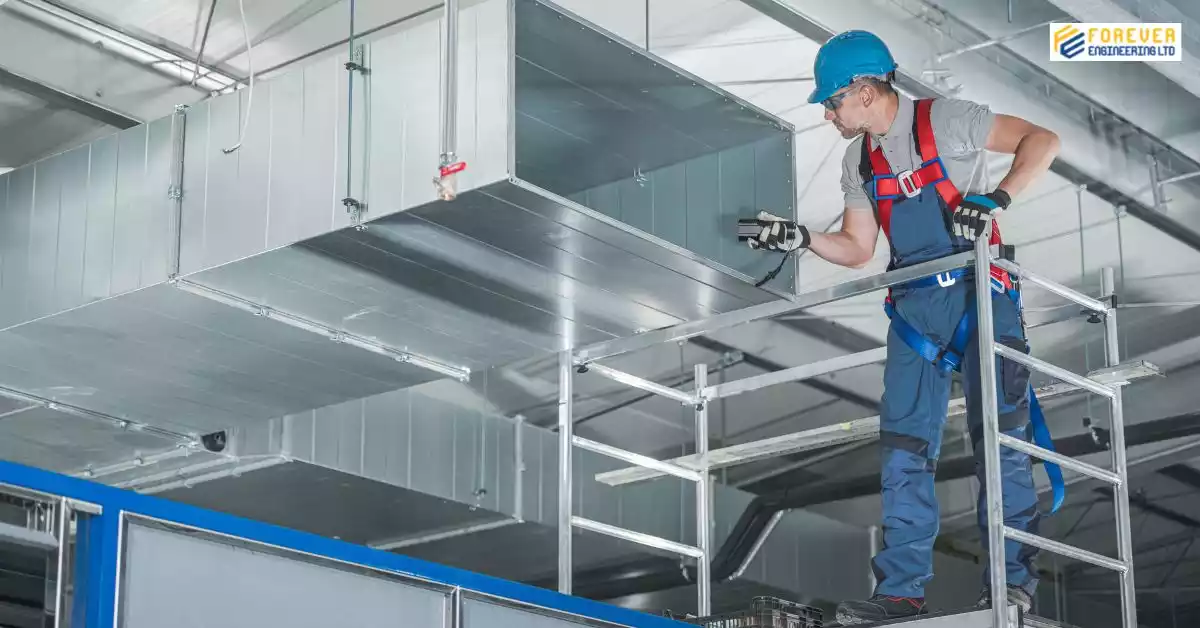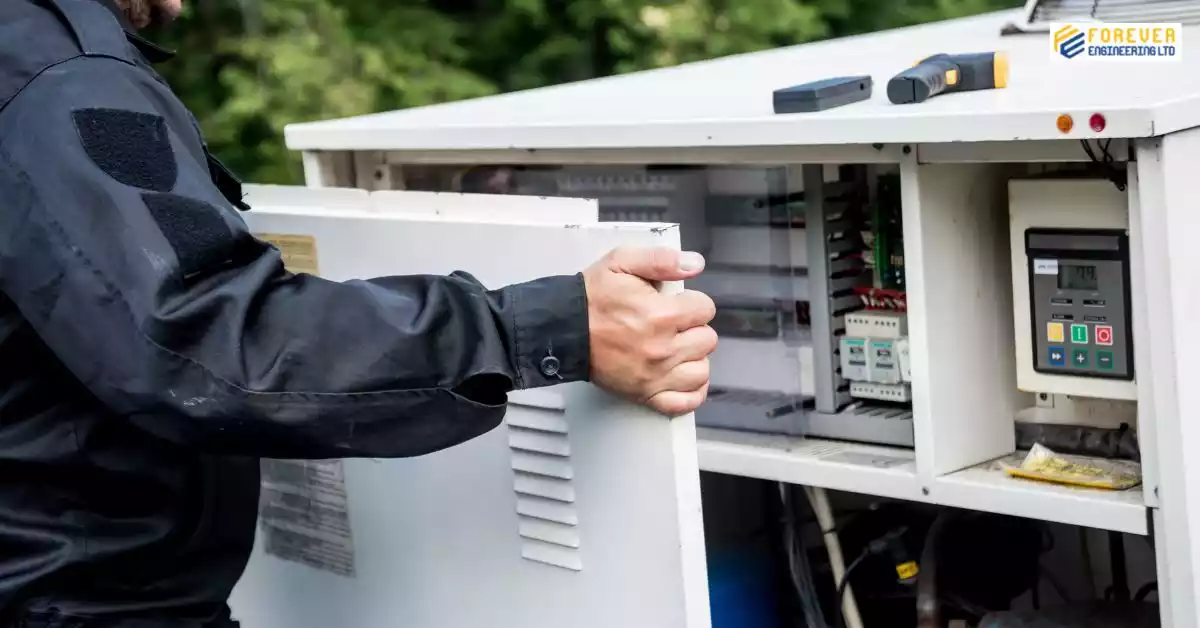In Bangladesh’s tropical warmth, where seasons dance between sultry summers and mild winters, the quest for indoor comfort has become more relevant than ever.
Installing an efficient Heating, Ventilation, and Air Conditioning (HVAC) system is central to achieving this comfort. This comprehensive guide dives deep into the essentials of HVAC installation, tailored specifically for Bangladeshi households. It ensures a blend of comfort, energy efficiency, and air quality that transforms your home into a sanctuary.
How to Install an HVAC System?
Table of Contents
ToggleInstalling an HVAC system is a complex process involving several vital steps. Initially, it involves designing the system to match your home’s specific needs, including calculating the correct size of the HVAC unit, laying out ductwork, and placing vents for optimal air distribution. This phase is critical for ensuring the system’s efficiency and effectiveness in maintaining indoor comfort levels.
The DIY Dilemma: Expert Installation is Key
While the DIY spirit is commendable, installing an HVAC system alone is not recommended for several reasons. The installation process requires specialized knowledge and tools that most homeowners lack.
An improperly installed HVAC system can lead to inefficiencies, increased energy costs, and even safety hazards. Experts bring precision and skill that guarantee the system operates as intended, making professional installation the top choice for Bangladeshi households.
DIY vs. Professional Installation: Why Accuracy Matters
A startling statistic highlights that a significant percentage of HVAC systems are installed incorrectly, often as high as 70%. These errors predominantly occur in DIY installations, leading to systems that run inefficiently, break down more frequently, and fail to provide the desired comfort level.
The complexity of HVAC systems demands meticulous attention to detail, which professionals are trained to provide, ensuring your system is installed correctly the first time.
Step-by-Step Guide to the HVAC Installation Process
Installing an HVAC (heating, ventilation, and air conditioning) system is a game-changer in the quest for a comfortable home environment. This guide is designed to walk you through the process step by step, ensuring that every detail is covered. From initial assessments to the final tweaks, we’ve got you covered. Let’s embark on this journey to make your home the haven of comfort you deserve.

Step: 01— Understanding Your Needs
Home Evaluation:
The first step involves a thorough assessment of your home. This includes considering the size of your house, the number of rooms, the existing insulation, and the local climate. This evaluation helps determine the type and size of the HVAC system that best suits your needs.
Energy Assessment:
An energy audit is crucial to identify areas where energy efficiency can be improved. This might include sealing drafts around doors and windows or adding insulation. An energy-efficient home will require less from its HVAC system, saving you money in the long run.
Step: 02— Choosing the Right HVAC System
System Type:
Based on the initial assessment, you’ll need to decide between various types of HVAC systems, such as central air conditioning, heat pumps, or split systems. Each has pros and cons, tailored to different needs and home layouts.
Size Matters:
Getting the right size is crucial. A system that’s too large or too small for your home will not only be inefficient but could also lead to increased wear and tear. A professional HVAC installer can calculate the perfect size based on your home’s specifications.
Step: 03— Designing the Ductwork Layout
Custom Design:
If your home still needs ductwork installed or updated, this step is crucial. The ductwork layout is designed to ensure optimal airflow throughout the house. Proper design minimizes energy loss and ensures every room is comfortably heated or cooled.
Installation:
Installing ductwork is a task for professionals. It involves cutting through walls and ceilings, which requires precision to avoid structural damage.
Finding the Right Installer: Forever Engineering Ltd Leads the Way
Step: 04— Installing the HVAC Unit
Preparation:
The area where the main unit will be placed needs to be prepared before installation. This might involve constructing a concrete pad for an outdoor unit or ensuring there’s adequate space in a utility closet for an indoor unit.
Installation:
The HVAC unit, whether a furnace, air conditioner, or heat pump, is installed by connecting it to the power supply, ductwork, and thermostat. This step requires technical knowledge to ensure everything is hooked up correctly and safely.

Step: 05 — Thermostat Installation
Choosing a Location:
The thermostat should be placed in a central location away from direct sunlight, drafts, doorways, and windows. This ensures it accurately reads the home’s temperature.
Wiring:
The thermostat is then wired to the HVAC system. Smart thermostats, which can adjust your schedule and adjust temperatures accordingly, are famous for their convenience and energy-saving potential.
Step: 06 — System Testing and Final Adjustments
Testing:
Once everything is installed, the system is tested to ensure it works properly. This includes checking that the unit turns on and off as expected, air flows correctly through the ducts, and the thermostat accurately controls the system.
Fine-tuning:
It’s common to need some adjustments after the initial test. This might involve balancing the ductwork for even air distribution or making minor changes to the thermostat settings.

Step: 07 — Maintenance Briefing
Education:
The final step involves educating you on properly maintaining your new HVAC system. This includes changing filters regularly, scheduling annual inspections, and tips on maximizing energy efficiency.
Documentation:
Ensure you receive all warranties and documentation for the system and any maintenance agreements.
Tips for Saving on HVAC Installation
Installing an HVAC system is a significant investment in your home’s comfort. However, the expense doesn’t have to break the bank. With intelligent planning and a few insider tips, you can save money on your HVAC installation without compromising quality or efficiency. Let’s explore how you can keep your costs down while ensuring your home remains a comfortable haven all year round.
1. Choose the Right Size
Oversized or undersized HVAC units are inefficient and cost more in the long run. An oversized unit cycles on and off too frequently, leading to excessive wear and tear. In contrast, an undersized unit struggles to maintain comfortable temperatures, running continuously and spiking energy bills. Have a professional calculate the precise load requirements for your home to ensure you purchase a unit that’s just the right size.
2. Seek Multiple Quotes: Comparison Shopping
Don’t settle for the first quote you receive. Prices and services can vary significantly between HVAC installation companies. Obtain at least three quotes to compare prices and understand what’s included in each service. This will help you get the best price and give you leverage in negotiations.
3. Read Reviews and Ask for References
When seeking quotes, also consider the service provider’s reputation and reliability. Read online reviews and ask for references. Sometimes, paying a little extra for a company with a stellar reputation is worth it for the peace of mind and quality of installation.
4. Take Advantage of Off-Season Discounts
HVAC companies tend to be busiest during the peak of summer and winter. Scheduling your installation during the off-season—spring or fall—can lead to significant savings. Many companies offer discounts during these times to keep their teams busy.

5. Consider Financing and Rebates
Some HVAC companies offer financing options, which can help spread out the cost of the system over time. This can make the upfront investment more manageable without delaying the comfort improvements to your home.
6. Opt for Energy-Efficient Models
While energy-efficient models might have a higher upfront cost, they pay for themselves in the long run through lower utility bills. Look for systems with a high SEER (Seasonal Energy Efficiency Ratio) rating for air conditioners or a high AFUE (Annual Fuel Utilization Efficiency) rating for furnaces. These units use less energy to achieve the same comfort level, leading to substantial savings over time.
Frequently Asked Questions (FAQ’s)
Installation typically takes 3 to 5 days, depending on the complexity of the system.
Studies suggest up to 70% of systems may be installed incorrectly, highlighting the importance of professional installation.
While it’s possible for those with technical skills, professional installation ensures safety, efficiency, and compliance with regulations.
At least once a year, ideally before the heating or cooling season begins.
Frequent repairs, increasing energy bills, and uneven temperatures throughout the home indicate that a new system might be needed.
Regular maintenance, upgrading to a high-efficiency system, and ensuring your home is well-insulated can improve energy efficiency.
Conclusion
Adhering to the detailed steps outlined above guarantees a smooth and successful HVAC installation process, setting the stage for years of efficient and comfortable living in your home. While the process may seem daunting, partnering with the right professionals can make all the difference, turning your dream of a perfectly climate-controlled home into reality.
In Bangladesh, Forever Engineering Ltd shines as a pinnacle of excellence, ensuring your HVAC system installation is not just an investment in your home but a pledge for years of comfortable, efficient living.

